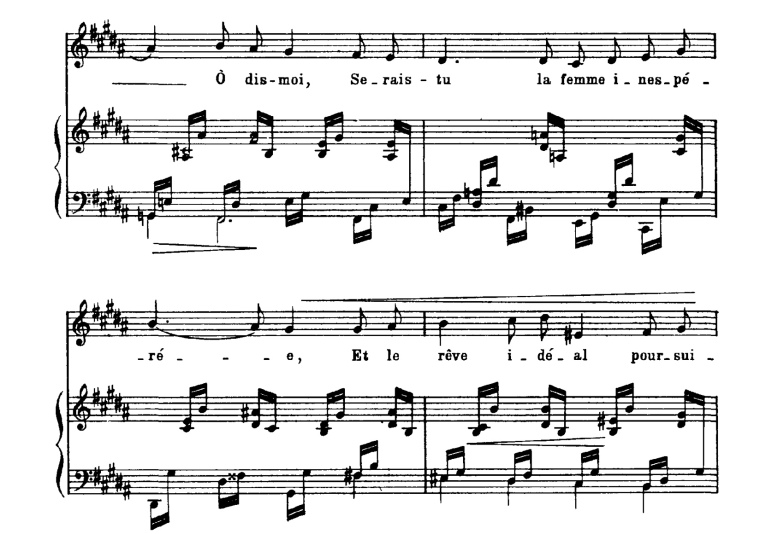After an extremely busy end of season, I thought it would be a nice idea to do a little diction post on this platform about one of my favorite subjects: Liaison
Liaison occurs when the usually silent final consonant of a word is pronounced because it is followed by a word starting with a vowel or a mute h. Please note, we never pronounce the “h” sounds in French as we do in English (like in the word “hat.”) For more on the h in French, click here as I have dedicated an entire blog post to this letter, which is ironically not pronounced in French.
In modern-day French, the use of liaison is something native speakers use or don’t use without giving it much thought. The French language is a living language, and so it evolves. There are many times where a native French speaker omits the use of any liaison because it makes the language sound somewhat stiff, but in classical singing, this is a different story.
Because the lyric art deals mainly with poetic verse, we strongly recommend using all appropriate liaisons while singing. For this, complete knowledge of all the types of liaison is essential to singing French text correctly. Do all native French speakers know the rules of liaison? No. They may understand by instinct what sounds better, but they usually can’t cite why they know this. I believe this to be true of all native speakers in every language. Typically, you would not be able to note any rules unless you have studied linguistics. Today, I would like to look at one of the most important forbidden liaisons and its exceptions.
Three Types of Liaisons
- The required liaison: Links that we must make to communicate the text properly.
- The optional liaison: Links that can be omitted based on taste.
- The forbidden liaison: Links that are strictly forbidden.
The Singular Noun and Liaison
When a noun is in its plural form, we expect to link from the -s representing the plural to the following word starting with a vowel. This -s is otherwise silent.
Les chiens couchés sur l’herbe. (The dogs lying on the grass)
[lɛ ʃjɛ̃ kuˈʃe syr lɛrbe]
In this sentence, the word for dog “chien” is plural, but it is followed by a word beginning with a consonant which means the final -s remains silent.
Les chiens étendus sur l’herbe. (The dogs lying on the grass)
[lɛ ʃjɛ̃z‿etɑ̃ˈdy syr lɛrbe]
In this sentence, the word for dog “chien” is also plural, but it is followed by a word beginning with a vowel which means the final -s, is pronounced as a vocalic [z] sound.
What happens when a vowel sound follows a singular noun? It is forbidden to link a singular noun to the following word starting with a vowel. You may link a singular adjective but not a noun.
Le chien est dehors (The dog is outdoors)
[lɛ ʃjɛ̃ ɛ dəˈɔr]
In this sentence the word “chien” is singular and is not linked with the following word as this would cause confusion and make the text difficult to understand.
You mustn’t confuse this rule of liaison with élision. When we work with élision (the omission of a final, unstressed -e in a word followed by a word beginning with a vowel or a mute h.), we may link to the following word starting with a vowel.
La chaîne est brisée (the chain is broken)
[la ʃɛn‿ɛ briˈze(ə)]
In this sentence, the word chaîne is a singular noun. The word chaîne is a singular noun in this sentence, but it ends with a schwa (French mute -e). Because of this, it cannot be called a liaison, and we link with élision, which doesn’t have so many rules or exceptions.
Exceptions
Every time I cite a rule in my diciton classes, I always add the word “usually” and never the word “always”. For every French diction rule, there are (almost) always several exceptions. So what about this forbidden liaison?
- In the following three expressions, we allowed to make a liaison from a singular noun (I make my students memorize this list):
- “mot à mot” (word for word) [mot‿a mot]
- “de temps en temps” (from time to time) [də tɑ̃z‿ɑ̃ tɑ̃]
- “nuit et jour” (night and day) [nɥit‿e ʒur]
In any other sentence or expression, these words may not be linked to the following word starting with a vowel as you will see in the following example:
La nuit étoilée (The starry night) [la nɥi etwaˈle(ə)]
Notice that we do not link nuit and étoilée and the -t is silent.
2. In the following nouns mostly found in opera, and only in some instances this rule is forgiven:
- Enfant:
Cet enfant a dormi (Faust, Gounod) [sɛt‿ɑ̃ˈfɑ̃(t)‿a dɔrˈmi]
enfant abandonnée (Hérodiade, Massenet) [ɑ̃ˈfɑ̃(t)‿abɑ̃dɔˈne(ə)]
Note: This liaison is not advised by Bernac but it is commonly done in performance practice.
- Bois:
Bois épais (Amidis, Lully) [bwa(z)‿eˈpɛ]
- Voix:
Obéissons quand leur voix appelle. (Manon, Massenet) [ɔbeiˈsõ kɑ̃ lœr vwa(z)‿aˈpɛlə]
Note: The singer should always make liaison lightly, but the parentheses surrounding the [t] and [z] in the examples above emphasize that the singer should do these particular links even more lightly than any other.
When navigating the world of French lyric diction and particularly the rules of liaison, please be sure to consult someone who is familiar with not only when and if these should be made, but why. If you are armed with knowledge, you will eliminate any extra doubts you may have while singing.Arm yourself with knowledge and you will eliminate any extra doubts you may have, which is one less thing to worry about while performing!





















You must be logged in to post a comment.